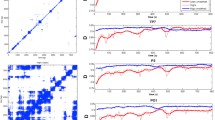Abstract
Ten normal subjects were tested on a large battery of physiological and psychological tests 12 h after a hypnotic dose of butobarbitone sodium (100 or 200 mg) or nitrazepam (5 or 10 mg) and compared with a placebo. The subjects received all five treatments in a balanced design. The tests used included self-ratings, the electroencephalogram, the auditory electroencephalographic evoked response, reaction time, tapping, card-sorting and the digit symbol substitution test. Both drugs were effective hypnotics according to the ratings but butobarbitone had more subjective “hangover” the following morning. The electroencephalogram showed significant changes after both drugs but the evoked response was affected most by 10 mg nitrazepam. The psychological tests showed some dose-related impairment after both drugs. Bioassay statistics suggested that with respect to these residual effects the relative potency of nitrazepam to butobarbitone was 27∶1.
Similar content being viewed by others
References
Dunlop, D.: Abuse of drugs by the public and by doctors. Brit. med. Bull. 26, 236–239 (1970).
Finney, D. J.: Statistical Method in Biological Assay, 2nd ed. London: Griffin 1964.
Gibson, H. B.: Manual of Gibson Spiral Maze. London: Univ. of London Press 1965.
Haider, I.: A double-blind controlled trial of a non-barbiturate hypnotic—nitrazepam. Brit. J. Psychiat. 114, 337–343 (1968).
Jarvis, M. J., Lader, M. H.: The effects of nitrous oxide on the auditory evoked response in a reaction time task. Psychopharmacologia (Berl.) 20, 201–212 (1971).
Kales, A., Kales, J. D., Scharf, M. B., Tan, T.-L.: All-night EEG studies of chloral hydrate, flurazepam and methaqualone. Arch. gen. Psychiat. 23, 219–225 (1970a).
—, Preston, T. A., Tan, T.-L., Allen, C.: All-night EEG studies of glutethimide, methyprylon and pentobarbital. Arch. gen. Psychiat. 23, 211–218 (1970b).
Kornetsky, C., Vates, T. S., Kessler, E. K.: A comparison of hypnotic and residual psychological effects of single doses of chlorpromazine and secobarbital in man. J. Pharmacol. exp. Ther. 127, 51–54 (1959).
Lader, M. H., Norris, H.: The effects of nitrous oxide on the human auditory evoked response. Psychopharmacologia (Berl.) 16, 115–127 (1969).
—, Wing, L.: Physiological Measures, Sedative Drugs and Morbid Anxiety. (Maudsley Monograph.) London: Oxford University Press 1966.
Lasagna, L.: A comparison of hypnotic agents. J. Pharmacol. exp. Ther. 3, 9–20 (1954).
Malpas, A., Rowan, A. J., Joyce, C. R. B., Scott, D. F.: Persistent behavioural and electroencephalographic changes after single doses of nitrazepam and amylobarbitone sodium. Brit. med. J. 1970 II, 762–764.
Matthew, H., Proudfoot, A. T., Aitken, R. C. B., Raeburn, J. A., Wright, N.: Nitrazepam—a safe hypnotic. Brit. med. J. 1969 III, 23–25.
Montagu, J. D.: Effects of quinalbarbitone and nitrazepam on the EEG in man: quantitative investigations. Europ. J. Pharmacol. 14, 238–249 (1971).
Oswald, I., Priest, R. G.: Five weeks to escape the sleeping-pill habit. Brit. med. J. 1965 II, 1093–1095.
Parsons, T. W.: Clinical comparison of barbiturates as hypnotics. Brit. med. J. 1963 II, 1035–1037.
Reider, J.: Methoden zur Bestimmung von 1,3-Dihydro-7-nitro-5-phenyl-2H-1, 4-benzodiazepin-2-on und seine Hauptmetaboliteu in biologischen Proben und Ergebnisse von Versuchen über die Pharmakokinetik und den Metabolismus dieser Substanz bei Mensch und Ratte. Arzneimittel-Forsch. 15, 1134–1148 (1965).
Von Felsinger, J. M., Lasagna, L., Beecher, H. K.: The persistence of mental impairment following a hypnotic dose of a barbiturate. J. Pharmacol. exp. Ther. 109, 284–291 (1953).
Wechsler, D.: Manual for the Wechsler adult intelligence scale. New York: Psychological Corporation. London: National Foundation for Educational Research (1955).
Williams, E. J.: Experimental designs balanced for the estimation of residual effects of treatments. Aust. J. sci. Reg. A. 2, 149–156 (1949).
Winer, B. J.: Statistical Principles in Experimental Design. New York: McGraw-Hill 1962.
Author information
Authors and Affiliations
Rights and permissions
About this article
Cite this article
Bond, A.J., Lader, M.H. Residual effects of hypnotics. Psychopharmacologia 25, 117–132 (1972). https://doi.org/10.1007/BF00423189
Received:
Issue Date:
DOI: https://doi.org/10.1007/BF00423189



